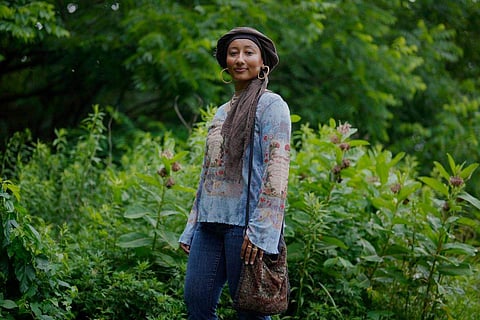
- LIFESTYLE
- FASHION
- FOOD
- ENTERTAINMENT
- EVENTS
- CULTURE
- VIDEOS
- WEB STORIES
- GALLERIES
- GADGETS
- CAR & BIKE
- SOCIETY
- TRAVEL
- NORTH EAST
- INDULGE CONNECT

College interns and young workers are donning wide-legged slacks at the office. The claw clip, a retro hair staple, is back; as are mesh tops, miniskirts and a host of colourful apparel that can make consumers look like they stepped out of a Disney Channel show from 2004.
Fueled by social media platforms including TikTok, the so-called Y2K trend resurfaced as consumers began attending parties and going out after pandemic lockdowns. What began with hair accessories like butterfly clips and the comeback of straight-leg jeans has expanded to all-denim garments, cargo and flare pants and everything shiny, among other looks.
Casey Lewis, a New York trend analyst, noted so many micro trends — often tagged with the suffix “core” — cranked up in the past few years that she created a newsletter about them. Think “Barbiecore” and “mermaidcore,” which highlight the hot pink reminiscent of Mattel Inc.'s Barbie doll or sheer materials with ocean-like hues and sequins. There's also “coastal granddaughter,” the youthful update that evolved from the “coastal grandmother” trend featuring oversized cardigans and linen sets.
“Gen Z is not even close to being done revisiting these old trends,” said Lewis, whose “After School” newsletter documents youth consumer behaviour. “They are going to dig into every weird trend from way back when and bring it back.”
Retailers from high-end Nordstrom to discounters and fast fashion outlets are pushing the styles in campaigns and on shelves. And consumers seem to be eating it up. Sales of women’s cargo pants jumped 81 per cent from January to May, the latest month of available data, according to Circana, which tracks retail purchases.
The company also is seeing a big jump in sales of flared pants, corset tops, metallic-coloured clothing and women's tracksuits, which are often made from bright velour fabric reminiscent of some wardrobe choices by socialite Paris Hilton at the height of her popularity.
Style watchers classify it as part of the McBling era, which overlaps with Y2K but emphasizes flashier items personified by brands like Juicy Couture and Baby Phat, the iconic streetwear line by TV personality and designer Kimora Lee Simmons, which relaunched in 2019.
As always, trends are fueled by celebrities like model Bella Hadid, whose outfit choices are analysed by fashion magazines and other on-lookers. Style also bubbles up directly from consumers via social media, challenging retailers accustomed to runway shows setting the tone. “There’s not a year advanced notice that these trends are going to trickle down,” said Kristen Classi-Zummo, an analyst who covers fashion apparel for Circana.
Retailers, including Macy’s and Walmart, said they are paying closer attention to what pops up on social sites and analyzing topics searched by users. But it can be challenging to recognize the difference between trends that just generate attention versus those shoppers will actually buy, said Jake Bjorseth, who runs trndsttrs, an agency helping companies reach young consumers.
Despite retailers catering to young consumers, many aren't really buying. Instead, they are wearing items from each others' closets, helping fuel a resale market that has tripled since 2020, according to research by Boston Consulting Group and Vestiare Collective, a French luxury resale site. Affordability was the primary driver, but shoppers also bought used items to be more planet-friendly.
Yasmeen Bekhit, a 22-year-old graduate student in Manheim, Pennsylvania, said she frequents a local thrift shop almost every week and shops at resale sites like Depop, which offers Y2K-heavy options such as baguette bags and baggy jeans.
Bekhit typically gravitates toward looser, flowy pants, flare-legged jeans and tighter shirts like mesh tops, which help her stay cooler in the summer while wearing a hijab. She's inspired by the way former Disney Channel stars like Gomez and Hilary Duff used to style themselves, she said.
Popular TikTok influencer Aliyah Bah, who amassed more than 2.5 million followers showcasing her Y2K-inspired look known as “Aliyahcore,” also inspires Bekhit. The look is a bit more alternative, often featuring miniskirts or shorts matched with crop tops, fishnet stockings and furry knee-high boots.
“I really love her way of styling outfits,” Bekhit said. But for every day, Bekhit said she typically looks up outfit ideas on social media and puts her own twist on them.
Retro hair also is making a splash. Tahlya Loveday, a master stylist at the The Drawing Room New York Salon, said she has seen a lot more '90s and Y2K trends, like spiky updos and space buns, bouncy blow-dried looks and block colouring, where sections of hair are coloured in contrasting colours. Gen Z clients embrace those looks more than millennials, she said.
“For Gen Z, this is all new to them,” Circana’s Classi-Zummo said. “They’re really not reliving it. So while we might see it as something that’s cyclical and coming back, they’re kind of getting it for the first time.”